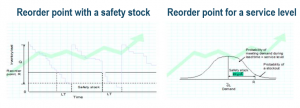Improving your product replenishment system delivers results fast and usually faster than CAPEX hungry development projects requiring multiple parties or modern technology. The more SKUs (Stock Keeping Units) in the range, the bigger the benefit from getting the inventory replenishment process right.
Typically, if a business carries a large range of products, the benefits become more significant. Moreover, if there are several locations or stores to manage, the benefits become even greater. We established that businesses in whichever sector they are in (retail, wholesaler) realise a return within short time through optimising their product replenishment processes.
Whether you handle groceries, building materials, toys, books, car parts, or gifts, the same fundamental principles apply. The companies that typically benefit most from implementing an automated replenishment system tailored to their business needs are generally those where;
- A significant amount of capital is tied up in stock, which could be invested elsewhere
- Product availability is unacceptably low leading to lost sales
- The total cost of replenishment is significant and needs to be reduced
- Replenishment ordering is done by multiple people in the business
What are the benefits to you?
For companies that need to manage the inventory of a large number of SKU’s across several locations, one of the most effective ways of making product replenishment more accurate and efficient is to implement a replenishment system tailored to the business’s operations. Manual ordering of several products for a large number of different locations will inevitably consume a lot of time and resources.
An efficient replenishment system will deliver key benefits;
- Reduced process costs
- Lower stock levels
- Better stock rotation
- Reduced wastage
- Improved availability
An automated replenishment system never stops working. It constantly monitors stock, sales and demand. Human errors, such as forgetting to place an order, are eliminated. A robust replenishment system continually monitors fluctuations in forecast demand takes into account seasonality by category as well as location (regional products behave differently) and amends orders accordingly.
Well calibrated replenishment systems classify products individually and assign them different attributes. Service level targets can be set higher for products that have a higher rate of sales, Safety stock requirements of each SKU can be evaluated accurately based on delivery lead time, delivery frequency, seasonality, forecast demand and MOQTY (Minimum Order Quantity). The greater degree of accuracy in inventory management delivered by a robust replenishment system makes it possible to increase service levels and inventory turnover as well as well as making the replenishment process more cost effective.
What kind of system do I need?
Systems need to fit round the companies, be capable of being customised to support the specific features of their supply chain and must have certain essential features. The system must support automatic demand forecasting at SKU level and be able to take into account periodic or seasonal variations with efficient safety stock levels for each SKU, whilst incorporating delivery lead times.
eXPD8 Analytics can deliver fundamental improvements to your supply chain, optimise your stock holding and improve your availability to your customers. We have years of experience in the FMCG sector, in forecasting, planning and the supply chain.
We love a challenge and would be happy to have a no obligations discussion to show how we can help your business to be more efficient, more robust and more successful.
Head of Data and Analytics
nelsonr@expd8.co.uk



